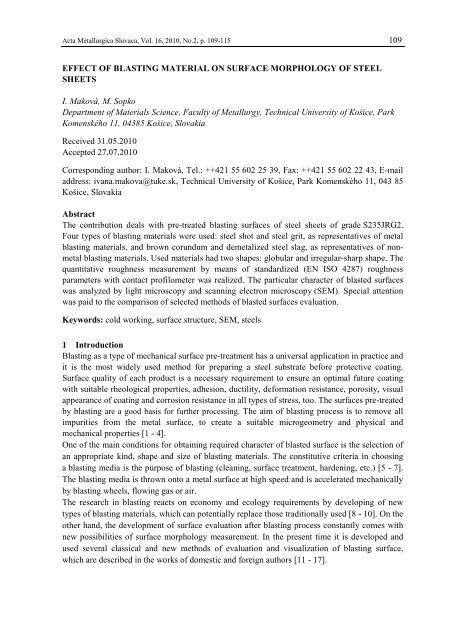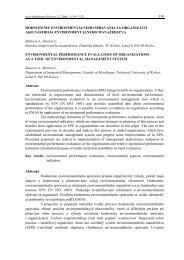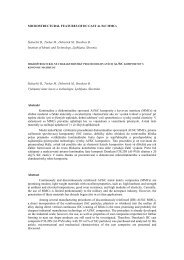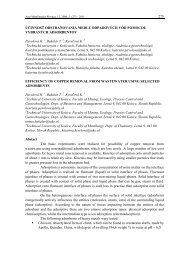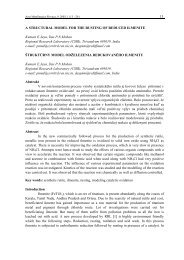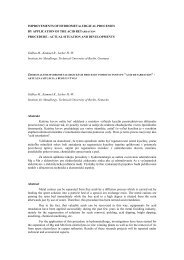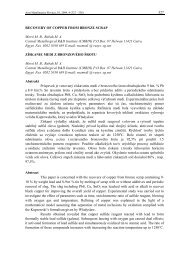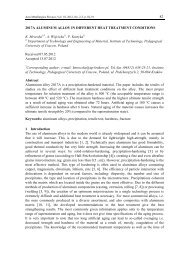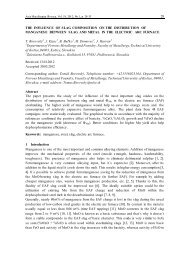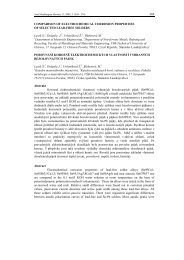109 EFFECT OF BLASTING MATERIAL ON SURFACE ...
109 EFFECT OF BLASTING MATERIAL ON SURFACE ...
109 EFFECT OF BLASTING MATERIAL ON SURFACE ...
Create successful ePaper yourself
Turn your PDF publications into a flip-book with our unique Google optimized e-Paper software.
Acta Metallurgica Slovaca, Vol. 16, 2010, No.2, p. <strong>109</strong>-115 113in contrast to the surfaces blasted with irregular-sharp blasting materials (OD 0.71; K 0.9; DOT0.9). An irregular profile with amount of sharp peaks and hollows are clearly visible.Fig.3 Cross-sections of blasted surfaces3.3 Scanning microscopySurface craters after blasting with OG 0.9 perfectly correspond with used shape and especiallywith type of used globular grain of blasting material. Surfaces are well-defined by intersectingglobular contour (Fig. 4 a, b). The surface detail shows that globular particles don’t create deepcraters (Fig. 4 c).Fig.4 SEM images of surface morphology induced by blasting with OG 0.9 a), b) general view, c) detail viewSteel grit (OD 0.71) as a representative of irregular - sharp blasting materials caused nonoriented,intersecting sharp lips (Fig. 5 a, b). A detailed look at the areas with differentorientation of surface scratches is on Fig. 5 c. The surface morphology shows considerablydifferent view in contrast to the surface blasted with OG 0.9.Fig.5 SEM images of surface morphology induced by blasting with OD 0.71 a), b) general view, c) detail view
Acta Metallurgica Slovaca, Vol. 16, 2010, No.2, p. <strong>109</strong>-115 114Surface blasted with brown corundum (K 0.9) is characterized by strong heterogeneity andsurface roughness (Fig. 6 b, c). The typical feature of this surface is presence of residues ofcorundum grains (Fig. 6 a) with negative influence on the properties.Fig.6 SEM images of surface morphology induced by blasting with K 0.9 a), b) general view, c) detail viewDemetalized steel slag (DOT 0.9) is a potentially new blasting material of non-metal type. Thesurface pre-treated by this type of blasting material has the smallest surface roughness incontrast to the surfaces blasted with irregular-sharp blasting materials. The reason of this factwe can be found in low weight of slag and low kinetic energy caused by the fall to steel surface.In the moment of particles fall, the slag crumbled into smaller pieces - surface craters weretherefore less obvious (Fig. 7 b, c). In case of demetalized steel slag, the presence of powderproportion on the surface was confirmed, see Fig. 7 a.Fig.7 SEM images of surface morphology induced by blasting with DOT 0.9 a),b) general view, c) detail view4 ConclusionsBased on the results of roughness measurements and microscopic analysis of tested samples thefollowing conclusions can be stated:1. The shape and type of blasting materials significantly affects the surface morphology ofthe investigated steel sheets. Globular particles of blasting materials (steel shot) causemore uniform surface morphology that consists of mutually intersecting spherical areas.Removal of the substrate is not significant and measured roughness parameters areminimal. Irregular and sharp particles of blasting materials - (steel grit, browncorundum, demetalized steel slag) create non-oriented relief with amount of sharp lipsin substrate material. Surface traces after blasting with different blasting materials differin cutting intensity, surface quality and content of negative secondary impurities of thesurface (brown corundum - residues of blasting material, demetalized steel slag -powder proportion). Steel surface blasted with brown corundum and steel grit shows
Acta Metallurgica Slovaca, Vol. 16, 2010, No.2, p. <strong>109</strong>-115 115the most relevant surface deformation. The peaks and hollows were deep and verysharp. Knowledge about the impact of various types and shapes of blasting materialsare very valuable for obtaining the expected state of the surface.2. For the complex and concise evaluation of blasted surfaces morphology it is necessaryto use and combine several methods of evaluation since the evaluation with roughnessparameter Ra (arithmetic mean deviation) is insufficient. We propose to use additionalamplitude characteristics of roughness and spacing parameters, too.3. Microscopic analysis is accurate and valuable subsidiary for morphology evaluation ofblasted surfaces. The optical microscopy explained the principal differences of surfacemorphology after blasting with ground and irregular-sharp blasting materials. SEMidentified surface changes more closely and revealed the presence of secondaryimpurities on the blasted surfaces.4. The 2D form predicates about a little functionality of the surface and can ignore thesubstantial aspects of measured surface. The 3D evaluation is modern and realisticmethod of evaluation but at the moment is not normalized in Slovakia.References[1] J. Kudláček, K. Kreibich, K.: Povrchaři, Vol. 2, 2008, No. 9, 2008, p.1-3, (in Czech).[2] M. Mihaliková, M. Buršák, J. Micheľ, K. Kovalová.: Journal of Metals, Materials andMinerals, Vol. 15, 2005, No. 2, p. 53-56.[3] A. Guzanová, J. Brezinová: Surface Treatment, Vol. 3, No. 2, 2006. p. 4 - 6, (in Slovak).[4] V. Schulze: Modern surface treatment, first ed., Wiley-VCH Verlag, Weinheim, 2006.[5] A. Momber: Blast cleaning technology, first ed., Springer, Berlin, 2008.[6] D. Draganovská, V. Bačová, J. Vináš: Acta Mechanica Slovaca. Vol.12, 2008, No.4 -B, p.76-82.[7] J. Ševčíková, M. Hagarová: Surface Engineering, first ed., TU HF, Košice, 2007, (inSlovak).[8] E. Uhlmann, A. Merniss: Production Engineering. Vol. 2, 2008, No. 2, p.133-138.[9] G. Andronikos, P. Valiadis, P. Vassiliou: Anti-Corrosion methods and materials. Vol. 45,1998, No. 3, p.153-157.[10] [21.5.2010], http://www.wrap.org.uk/downloads/AbrasiveBlastMediaLiteratureReview.a2e9ddd3.436.pdf[11] Ch. K Poorna et al.: Materials and Design, Vol. 30, 2009, p. 2895 - 2902.[12] V. Bačová, D. Draganovská: Materials Science, Vol.40, 2004, No.1, p.125-131.[13] J. Day, X. Huang, N.L. Richards: Journal of Thermal Spray Technology, Vol. 14, 2005,No.4, p. 471-479.[14] S. Amada, T. Hirose: Surface and Coatings technology, Vol. 130, 2000, No.2-3, p.158-163.[15] J. Schmähling, F.A. Hamprecht, D.M.P. Hoffmann: International Journal of Machine Tools& Manufacture, Vol. 46, 2006, p. 1764 -1769.[16] S. Kurokawa, Y. Ariura: Journal of Physics: Conference Series, Vol. 13, 2005, p.9 -12.[17] V. Sedláček: Metal Surfaces and Coatings, first ed., ES ČVUT, Praha, 1992, (in Czech).[18] [21.1.2010], http://www.blastingaccessories.com/abrasives/abrasives.html[19] EN ISO 4287: 1999 Geometrical product specifications (GPS) - Surface texture: Profilemethod - Terms, definitions and surface texture parameters.


